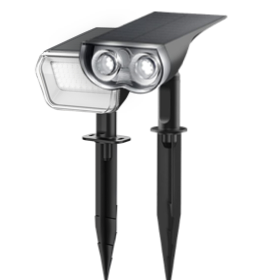Safeguarding Your Home with Outdoor Motion Sensor Lights
Safeguarding Your Home with Outdoor Motion Sensor Lights
In today's world, ensuring the safety and security of our homes is paramount. One effective way to enhance home security is by installing outdoor motion sensor lights. These innovative lights offer a proactive approach to home protection, providing illumination whenever motion is detected. In this article, we will delve into the world of outdoor motion sensor lights, exploring their benefits, types, functionality, and common challenges.

What is Motion Sensor Lights?
Motion sensor lights, also known as motion-activated lights, are lighting fixtures equipped with sensors that detect movement within their range. When motion is detected, these lights automatically illuminate, providing visibility in outdoor spaces. The primary purpose of motion sensor lights is to enhance security by deterring potential intruders and illuminating dark areas around the home.
Benefits of Motion Sensor Lights

1. Enhanced Home Security: Motion sensor lights serve as a proactive deterrent against potential intruders by instantly illuminating outdoor spaces upon detecting any suspicious activity. The sudden and powerful illumination startles intruders, effectively disrupting their plans and compelling them to reconsider any attempt to break into the property.
2. Energy Efficiency: One of the standout features of motion sensor lights is their energy-saving capability. By activating only when motion is detected, these lights minimize unnecessary energy consumption, leading to significant cost savings on electricity bills. Compared to traditional lighting systems that remain continuously switched on, motion sensor lights provide a more sustainable and eco-friendly lighting solution.
3. Increased Safety: Motion sensor lights play a crucial role in enhancing safety around the home, especially during nighttime. By illuminating pathways, driveways, and outdoor areas, they ensure clear visibility, reducing the risk of accidents and falls. This is particularly beneficial for families with children, elderly individuals, or guests navigating the outdoor space after dark.
4. Integration with Smart Home Systems: Motion sensor lights contribute to the advancement of smart home technology by seamlessly integrating with smart home systems. As one of the ten essential components of a smart home, motion sensor lights enhance the overall automation and efficiency of the home environment. By connecting to smart home hubs or platforms, such as Alexa or Google Home, users can control their motion sensor lights remotely, set schedules, and even create customized lighting scenes. This integration not only adds convenience but also enhances the overall functionality and intelligence of the home, aligning motion sensor lights with the modern trend of smart home technology.

Types of Outdoor Motion Sensor Lights
Spotlights: These lights emit a focused beam of light, making them perfect for accentuating specific areas such as entrances, driveways, and gardens. Their precise illumination helps highlight architectural features and landscaping elements, enhancing the overall aesthetics of your outdoor space.
The Linkind Smart Solar Spotlight SL5 stands out from traditional spotlights with its revolutionary smart features, offering group control and music sync functionality. With the SL5, you can effortlessly link multiple lights together in a group and control them simultaneously using the AiDot app. Plus, the unique music sync feature allows you to synchronize your lights with the beat of your favorite tunes, creating captivating visual effects that enhance any special occasion. This innovative spotlight sets up wirelessly in seconds, eliminating the need for hubs, wires, or complicated installations. Its advanced energy efficiency ensures all-night brilliance without draining your energy resources, while its exceptional durability and weather resistance guarantee long-lasting performance in any outdoor environment. With the Linkind Smart Solar Spotlight SL5, you can enjoy hassle-free, customizable lighting that transforms your outdoor space into a dynamic and inviting environment.
Group Control: The world's first solar spotlight with wireless capabilities to offer smart group control functionality. Multiple Convenient App Functions: Control smart spotlights with the AiDot App. Adjust color, temperature, brightness, and use group control, music sync, and energy-saving features. Music Sync & Preset Scenes: Sync RGBTW smart solar lights with music by granting microphone permission. Customize effects, preset scenes, or choose from 16 million colors to enhance your outdoor ambiance. Three Optional Lighting Modes: Linkind solar lights feature 3 modes: Motion for safety and efficiency, Luminance for automatic dusk-to-dawn lighting, and Continuous for constant illumination. Enhanced Lighting & Easy Installation: Linkind solar spotlights are adaptable for ground or wall mounting, with 360° horizontal and 180° vertical adjustability. 
Floodlights: Provide expansive and powerful illumination, covering large outdoor areas such as yards, parking lots, and sports fields. Their broad beam of light ensures comprehensive coverage, making them ideal for enhancing security and visibility in expansive outdoor areas.
Pathway Lights: Designed specifically for illuminating walkways, pathways, and garden paths, pathway lights offer both functional and decorative benefits. Their gentle illumination not only enhances safety by guiding footsteps but also adds a charming ambiance to outdoor landscapes, creating a welcoming atmosphere for visitors.
Wall-Mounted Lights: These lights are strategically installed on exterior walls to provide illumination for entrances, patios, decks, and other outdoor areas. With their versatile mounting options, wall-mounted lights offer flexibility in placement and direction, allowing you to customize the lighting layout to suit your specific needs.
Dual - Head Lights: Featuring two adjustable heads, dual-head lights offer versatility and customizable lighting options. They allow you to independently adjust each head to direct light precisely where it's needed, providing tailored illumination for different areas of your outdoor space. Recommended Winees F2 pro Camera, these lights not only enhance security but also offer additional surveillance capabilities, adding an extra layer of protection to your property.
The Winees F2 PRO Dual Lens 2K Floodlight Camera elevates security with its innovative design and advanced features. With a REAL 180° field-of-view, it offers comprehensive surveillance coverage, eliminating blind spots. Its powerful night lighting covers 180° horizontally each, illuminating wide nighttime areas up to a 66ft radius, enhancing visibility and deterring potential threats. The REAL 180° AI Detection feature employs Smart PIR motion detection with two sensors, delivering precise alerts to connected devices in real-time. Easy installation with a quick-release mounting system and multiple placement options ensures hassle-free setup. Plus, the motion-activated strobe light and siren provide an additional deterrent against intruders, ensuring your property's safety.
Difference Between Light Sensor vs Motion Sensor
It's crucial to distinguish between light sensors and motion sensors, as they serve different functions despite both being utilized in outdoor lighting systems. Light sensors are responsible for detecting ambient light levels and autonomously controlling light activation based on natural light conditions. Conversely, motion sensors are designed to detect movement and activate lights upon sensing motion. For a detailed comparison between these two types of sensors, please refer to the table below.
|
Aspect |
Light Sensor |
Motion Sensor |
Summary |
|
Usage Scenario |
Detects ambient light levels |
Detects movement |
Light sensors adjust lighting based on natural light, while motion sensors trigger lights in response to detected movement. |
|
Function |
Automatically adjusts lights based on natural light conditions |
Triggers lights to turn on/off when motion is detected |
Light sensors conserve energy by turning off lights during daylight, while motion sensors enhance security by activating lights in response to potential threats. |
|
Typical Application |
Typically used to conserve energy by turning off lights during daylight hours |
Used for security and convenience purposes |
Light sensors are commonly found in outdoor lighting fixtures like streetlights, while motion sensors are installed in security lights and floodlights. |
|
Benefits |
Ideal for providing consistent illumination in outdoor areas without manual intervention |
Enhances security by alerting homeowners to potential intruders |
Light sensors ensure consistent lighting levels, while motion sensors provide an immediate response to detected motion, improving safety and security. |
How Outdoor Motion Sensor Lights Work
Outdoor motion sensor lights operate based on the principle of motion detection. When motion is detected within the sensor's range, it sends a signal to the light fixture, triggering it to illuminate. The sensitivity and range of motion sensors can be adjusted to suit specific requirements, ensuring reliable detection and activation.
1. Detection of Motion: Outdoor motion sensor lights operate by continuously monitoring their designated area for any movement.
2. Signal Transmission: When motion is detected within the sensor's range, it promptly sends a signal to the light fixture.
3. Activation of Light Fixture: Upon receiving the signal, the light fixture is triggered to illuminate the surrounding area.
4. Adjustment of Sensitivity and Range: These sensors offer the flexibility to finely tune sensitivity and range settings to meet specific requirements.
5. Customization for Specific Needs: For example, a motion sensor light near a driveway can be configured to detect vehicles approaching from a distance. Similarly, one positioned near a doorway can be tailored to detect human movement within a closer range.
6. Enhanced Security and Convenience: The adaptability of outdoor motion sensor lights makes them an efficient and personalized solution for enhancing both security and convenience.
Overcoming Common Challenges
While outdoor motion sensor lights offer numerous benefits, they may encounter common challenges that need to be addressed:
False Alarms and Nuisance Tripping: External factors such as moving branches, passing animals, or sudden weather changes can trigger false alarms, leading to unnecessary activation of the lights. To minimize false activation, consider adjusting the sensitivity and positioning of the motion sensors. By fine-tuning these settings, you can reduce the likelihood of false alarms and ensure that the lights only activate when genuinely needed.
Pets and Wildlife Triggering Sensors: Small animals and wildlife roaming near your property may inadvertently trigger motion sensors, resulting in unnecessary activation of the lights. To address this issue, consider installing pet-friendly motion sensors or adjusting the angle of the sensors to reduce sensitivity to ground-level movement. Additionally, positioning the sensors at a higher elevation can help minimize false alarms caused by pets and wildlife, ensuring that the lights are activated only by relevant motion events.
Adjusting Settings for Changing Seasons: Changes in daylight hours and weather conditions throughout the seasons can affect the performance of motion sensor lights. To maintain optimal performance year-round, regularly check and adjust the sensitivity and activation settings of the motion sensors. By adapting these settings to accommodate seasonal variations, you can ensure that the lights respond effectively to motion events in any weather conditions, enhancing the overall security and functionality of your outdoor lighting system.
Conclusion
Outdoor motion sensor lights are a valuable addition to any home, offering a range of benefits including enhanced security, energy efficiency, and convenience. By detecting motion and illuminating outdoor spaces only when needed, these lights effectively deter potential intruders and provide peace of mind to homeowners. Despite some common challenges such as false alarms and sensitivity issues, the adaptability and effectiveness of motion sensor lights make them a worthwhile investment for improving home safety and functionality. With their ability to prevent break-ins and create well-lit surroundings, motion sensor lights are a practical and cost-effective solution for enhancing security and convenience around the home.
FAQs about Motion Sensor Lighting
Q1: How does a motion sensor spotlight work?
A motion sensor spotlight operates by detecting movement within its designated range. When motion is detected, the sensor triggers the light to illuminate the surrounding area. This sudden illumination serves as a deterrent to potential intruders and provides added security to outdoor spaces.
Q2: What are the disadvantages of motion sensor lights?
While motion sensor lights offer numerous benefits, they may have some drawbacks. Common disadvantages include false alarms triggered by passing animals or moving objects, potential sensitivity issues in extreme weather conditions, and the need for occasional maintenance to ensure optimal performance.
Q3: What is the difference between a light sensor and a motion sensor?
A light sensor, also known as a photocell, detects ambient light levels and automatically adjusts lighting based on natural light conditions. In contrast, a motion sensor detects movement within its range and triggers lights to turn on when motion is detected. While both sensors are used in outdoor lighting systems, they serve distinct purposes and operate based on different principles.
Q4: Are motion sensor lights worth it?
Yes, motion sensor lights are worth it for several reasons. They enhance home security by deterring potential intruders, conserve energy by only activating when motion is detected, and provide added convenience by automatically illuminating outdoor spaces when needed. Additionally, they offer peace of mind to homeowners by increasing visibility and reducing the risk of accidents in poorly lit areas.
Q5: How do motion sensor lights help prevent break-ins?
Motion sensor lights help prevent break-ins by serving as a proactive deterrent to potential intruders. The sudden illumination of outdoor spaces upon detecting motion startles intruders, making them think twice before attempting a break-in. Additionally, well-lit surroundings make it more challenging for intruders to remain undetected, increasing the likelihood of them being spotted and reported to authorities.
</h2id="how-outdoor-motion-sensor-lights-work">
-
Buy Securely on$54.89 $64.99Where to Buy:







































